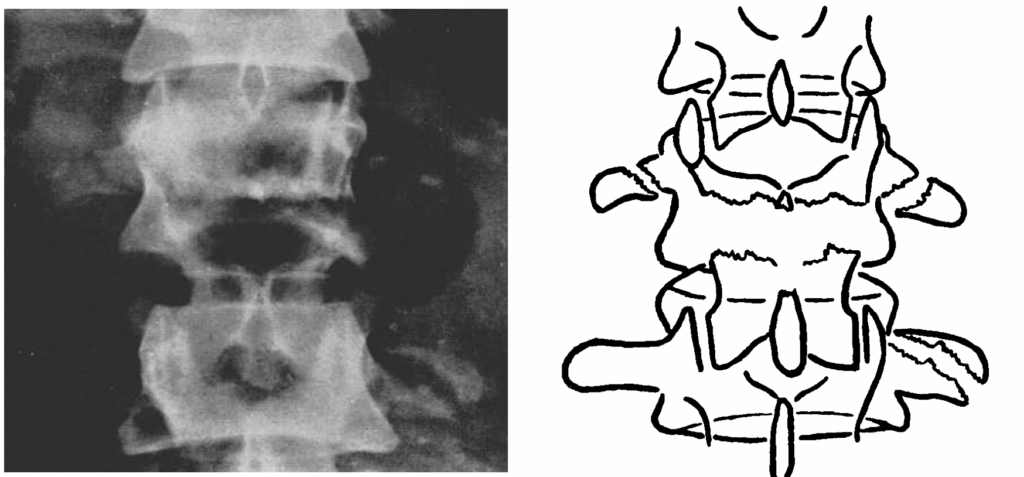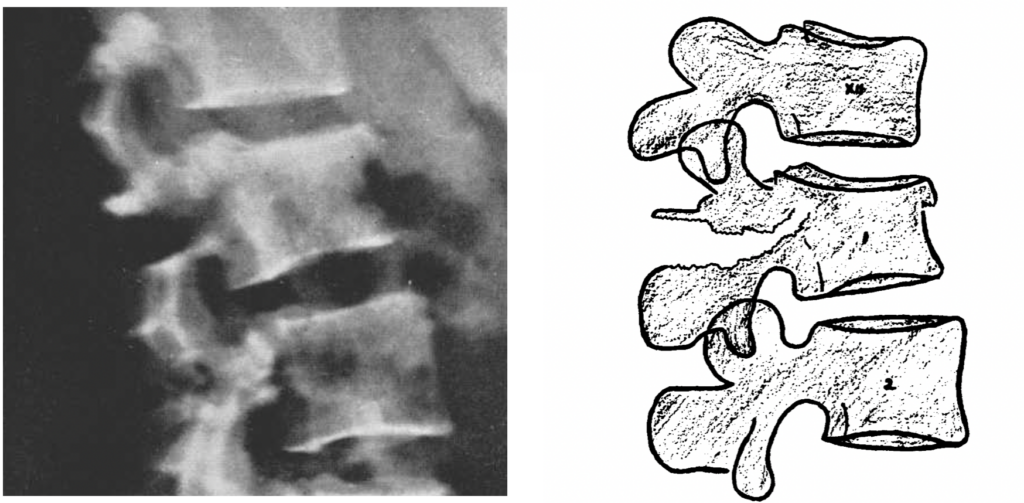Chance fracture
Description
The Chance fracture is a transverse fracture through a vertebral body and neural arch.
Chance-type fractures are subtle unstable injuries that are often associated with intraabdominal injuries. CT-based observations made during routine interpretations revealed involvement of a burst component to this fracture pattern.
Often termed a seat-belt injury, this injury occurs when there is flexion of the spine with the fulcrum of the force in the anterior abdominal wall, such as when one abruptly stops a vehicle with a lap-belt in place. This causes distraction of the posterior and middle, and possibly anterior, columns of the spine, creating an unstable injury.
A true Chance fracture consists of a horizontal splitting of the posterior elements and vertebral body; purely ligamentous and disc, and mixed soft tissue and osseous versions are now commonly lumped under the name Chance fracture.
These injuries typically occur at the thoracolumbar junction or in the upper lumbar spine. When the anterior ligaments are also injured, this injury may be a fracture-dislocation, carrying a higher incidence of neurological injury. With these fractures, one must always be alert to the high likelihood of injury to the bowel and other abdominal viscera.
History of the Chance fracture
The flexion-distraction fracture of the spine was first described in 1948. This pattern of injury had not been recognized before the use the lap seat belt
1948 – CG Chance published a Note on a type of Flexion Fracture of the Spine in the British Journal of Radiology. Initially he described a purely osseous injury.
When flexion of the spine exceeds normal limits something has to give way. This is usually the vertebral body, which assumes the characteristic wedging in varying degrees. Occasionally the body, for some reason, is relatively incompressible, so the posterior arch system is disrupted. The commonest types of posterior arch disruption are: (1) The ligamentous rupture with dislocation of the apophyseal joints, (2) Fractures of the articular processes, (3) Combinations of these.

The fracture which I illustrate is a true flexion fracture, though of a rarer type. It consists of a horizontal splitting of the spine and neural arch, ending in an upward curve which usually reaches the upper surface of the body just in front of the neural foramen.
In my three cases there has been very little wedging of the vertebral body, no dislocation of the apophyseal joints, nor has there been any cord damage…As there is no major ligamentous damage, the upper half of the fractured neural arch is firmly fixed to the normal arch of the vertebra above, and similarly the lower half is fixed to the vertebra below. The outline of these halves, in a horizontal plane, is therefore still undisturbed, so that a simple hyperextension of the spine must inevitably bring the two halves into perfect anatomical apposition, and give a near 100 per cent, prognosis.

1949 – EA Nicoll coined the term “Chance’s fracture” in his review of Fractures of the dorso-lumbar spine in the British volume of the Journal of Bone and Joint Surgery
A special type of laminar fracture has been described recently by GQ Chance (1948). In this, the fracture line is horizontal and is continued anteriorly into the body and posteriorly into the spinous process. There may be slight wedging but since the fracture line passes through bone all the way, and there is no subluxation of the facets, or rupture of the posterior ligament, reduction is followed by bony union which is stable. As Chance points out, failure to recognise these cases may lead to unnecessary grafting operations.
Nicoll 1949
1965 – Howland et al, unaware of Chance’s earlier publication, presented a case report of a “splitting apart” transverse fracture of a lumbar vertebra
A 19-year-old boy suffered a “splitting apart” transverse fracture of the third lumbar vertebra in an automobile accident. The fracture was due to a highly placed seat belt which acted as a central fulcrum.
A “splitting apart” fracture of a vertebral body has not, to our knowledge, been previously reported.
Howland, JAMA 1965

2. Presumed mechanism of “seat belt fracture” splits third lumbar vertebra horizontally into two portions
Howland, JAMA 1965
1969 – William S. Smith and Herbert Kaufer published their series of 24 lumbar spine injuries related to lap belt use. Twenty patients had unusual transverse-type fractures characterized by disruption and longitudinal separation of the posterior elements with minimal or no vertebral body compression or displacement. They termed this injury pattern the “Chance” fracture. Three patients in their series were noted to have sustained intraabdominal injuries. They proposed that the lap seat belt serves as the fulcrum, or axis of rotation, at the anterior abdominal wall, thus subjecting all spinal elements to flexion and distraction or tension forces.
2006 – Bernstein et al performed a retrospective review of 53 patients from the University of Maryland Shock Trauma Center trauma over an 8-year period. They found intraabdominal injuries occurred in 40% of flexion–distraction thoracolumbar fractures. They proposed a mechanism of injury for Chance-type fractures

Bernstein et al 2006
- A On sudden deceleration, point of contact of seat belt and abdomen serves as fulcrum, or axis of rotation, about which all structures posterior are subject to flexion and distractive forces.
- B With enough force, bone integrity is overcome and horizontal Chance fracture results. Curved arrows show axis of rotation.
- C With weakening of fractured spine, initial flexion–distraction force begins to involve an axial load component, driving axis of rotation (curved arrows) posteriorly.
- D Once axis of rotation (curved arrows) moves posterior to anterior vertebral body cortex, compression begins.
- E With ongoing force, axis of rotation (curved arrows) continues to migrate posteriorly in further weakened spine allowing greater axial loads that ultimately cause vertebral body to burst
Associated Persons
References
Original articles
- Chance GQ. Note on a type of flexion fracture of the spine. Br J Radiol. 1948 Sep; 21(249): 452
- Nicoll EA. Fractures of the dorso-lumbar spine. J Bone Joint Surg Br. 1949 Aug; 31B(3): 376-94
- Howland WJ, Curry JL, Buffington CB. Fulcrum Fractures of the Lumbar Spine: Transverse Fracture Induced by an Improperly Placed Seat Belt. JAMA 1965; 193: 240–241
Review articles
- Smith WS, Kaufer H. Patterns and mechanisms of lumbar injuries associated with lap seat belts. J Bone Joint Surg Am 1969; 51(2):239–254
- Bernstein MP, Mirvis SE, Shanmuganathan K. Chance-type fractures of the thoracolumbar spine: imaging analysis in 53 patients. AJR Am J Roentgenol. 2006 Oct;187(4):859-68
- Aebi M. Classification of thoracolumbar fractures and dislocations. Eur Spine J. 2010;19 Suppl 1 : S2-7
- Thakur JD et al. George Chance and Frank Holdsworth: Understanding Spinal Instability and the Evolution of Modern Spine Injury Classification Systems. Neurosurgery. 2020 Apr 16. pii: nyaa081. doi: 10.1093/neuros/nyaa081.
- Weerakkody Y. Chance fracture. Radiopaedia
[cite]
eponymictionary
the names behind the name

